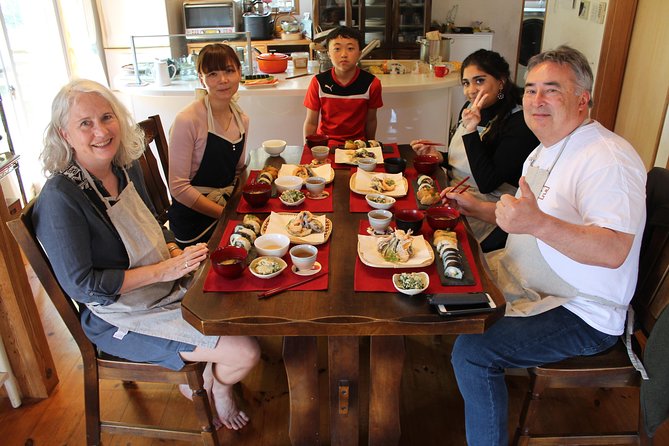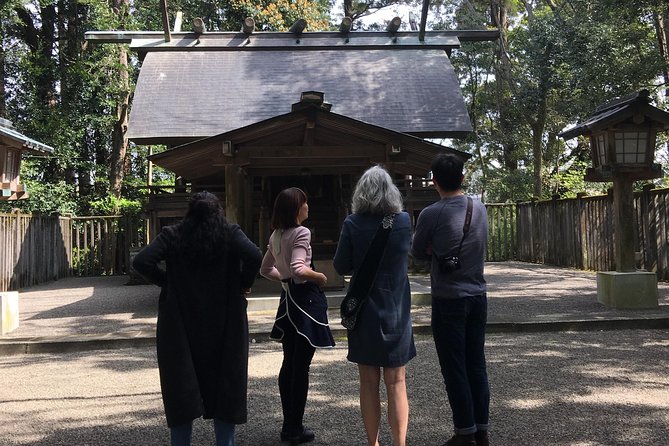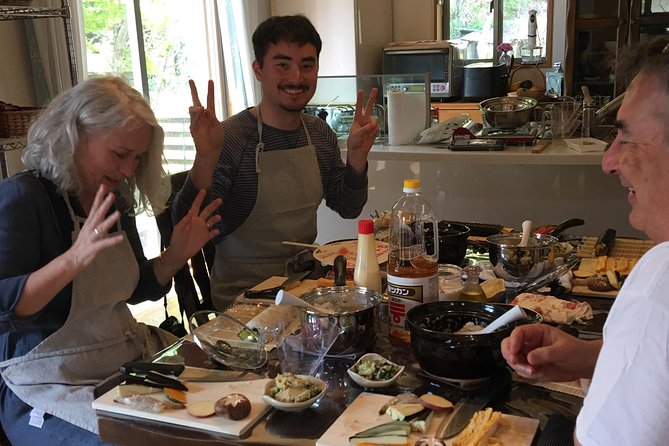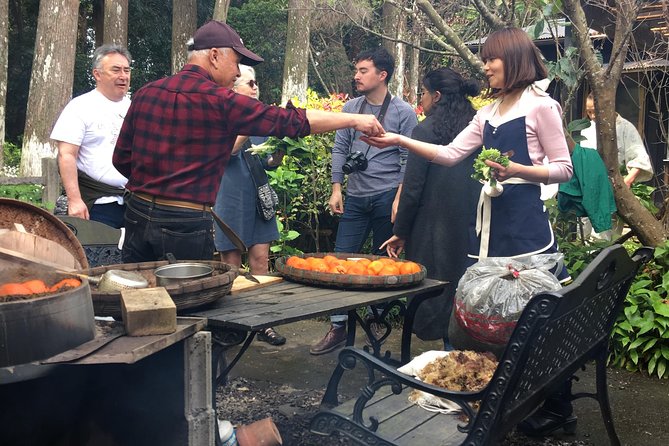Cooking Japanese food at home can be a delightful and enriching experience for any home chef. With the right ingredients and a bit of know-how, you can unlock the vibrant flavors and textures that define this captivating cuisine. From sourcing quality produce to mastering essential techniques, the keys to success lie in understanding the fundamentals. Whether you’re a seasoned cook or a curious beginner, exploring the world of Japanese home cooking promises a culinary adventure that’s sure to tantalize your taste buds. So, let’s dive in and discover the secrets to elevating your kitchen skills and bringing the essence of Japan right to your table.
Key Points

- Acquire authentic Japanese ingredients, such as mirin, miso, and dashi, by visiting local Asian grocery stores or shopping online to capture the true flavors.
- Master essential techniques, including sushi rolling, tempura frying, and forming the perfect nigiri rice mound, to recreate traditional Japanese dishes at home.
- Utilize umami-rich seasonings, like soy sauce and dashi, to enhance the flavors of sushi rice, okonomiyaki, and other Japanese specialties.
- Explore regional Japanese cuisine, such as the delicate sushi of Edo and the hearty okonomiyaki of Kansai, to expand your culinary repertoire.
- Adapt traditional recipes to home kitchens by substituting hard-to-find ingredients, adjusting cooking methods, and capturing the essence of Japanese dishes.
Selecting Authentic Ingredients

Selecting the right ingredients is crucial when cooking authentic Japanese dishes at home. Choosing top-quality, fresh produce and specialty items like mirin, miso, and dashi can make all the difference in capturing the true flavors of Japanese cuisine.
Visit your local Asian grocery store or look online to find authentic Japanese ingredients. Familiarize yourself with common staples like soy sauce, rice vinegar, and kombu, and don’t be afraid to experiment with lesser-known items like shichimi togarashi, a Japanese chili pepper blend.
You can also read our reviews of more food & drink experiences in Kyushu
Preparing Traditional Dishes
With the right ingredients in hand, home cooks can begin preparing a variety of traditional Japanese dishes.
From the delicate art of sushi rolling to the savory flavors of okonomiyaki, mastering these classic recipes requires patience and attention to detail.
Whether crafting delicate dumplings or layering bento box components, the keys lie in proper technique and an understanding of each dish’s distinct cultural heritage.
For example, the carefully orchestrated steps of nigiri sushi assembly ensure the perfect balance of rice, fish, and garnishes.
Similarly, okonomiyaki’s griddle-cooked batter and customizable toppings make for a satisfying and versatile meal.
Mastering Essential Techniques

Mastering essential techniques is key to preparing authentic Japanese dishes at home. From the delicate art of sushi rolling to the precise timing required for tempura frying, home cooks must develop a keen eye for detail and a steady hand.
Understanding the proper methods for each component – whether it’s forming the perfect nigiri rice mound or achieving the right batter consistency – ensures the flavors and textures shine through in the final dish.
Techniques like slicing vegetables into paper-thin strips, kneading dough to the right elasticity, and seasoning broths to balance umami notes all require practice. By honing these skills, home cooks can unlock the true essence of Japanese cuisine and confidently recreate it in their own kitchens.
Enhancing Flavors With Seasonings

Beyond honing essential techniques, Japanese home cooks rely on a thoughtful selection of seasonings to elevate the flavors of their dishes. From the umami-rich soy sauce that seasons sushi rice to the fragrant blend of spices that infuses okonomiyaki, these seasonings play a crucial role in unlocking the authentic taste of Japanese cuisine. Whether whisking together a marinade for succulent teriyaki or blending aromatic spices for a fragrant curry, mastering the art of seasoning is key to crafting delectable Japanese meals at home. Consider this guide to essential Japanese seasonings:
| Seasoning | Description | Common Uses |
|---|---|---|
| Soy Sauce | Fermented soy bean-based liquid with a rich, savory flavor | Sushi, stir-fries, marinades |
| Mirin | Sweet Japanese rice wine | Sauces, glazes, soups |
| Dashi | Flavorful broth made from kombu (kelp) and bonito (dried fish) | Miso soup, noodle dishes |
Exploring Regional Specialties

Delving into the diverse culinary traditions of Japan, home cooks can explore a rich tapestry of regional specialties that showcase the country’s dynamic food culture.
From the delicate sushi of Edo (Tokyo) to the hearty okonomiyaki of Kansai, each region boasts unique ingredients, preparation methods, and flavor profiles that reflect local terroir and heritage.
Dive into the savory gyoza dumplings of Nagasaki, the fragrant curry rice of Hokkaido, or the tantalizing tempura of Kanto.
By understanding these regional distinctions, home chefs can recreate authentic Japanese dishes and bring the country’s vibrant gastronomic diversity into their own kitchens.
Exploring these specialties offers a delicious journey through Japan’s culinary landscape.
Hosting a Japanese-Inspired Meal

Building on the exploration of regional specialties, hosting a Japanese-inspired meal at home allows home cooks to showcase the country’s vibrant culinary traditions. By thoughtfully curating a menu and setting the stage, home chefs can transport their guests on a delightful gastronomic journey through the flavors and techniques of Japan.
Some key elements to consider when hosting a Japanese-inspired meal include:
-
Selecting a balanced and authentic menu featuring classics like sushi, tempura, and bento boxes.
-
Incorporating traditional serveware and tableware to enhance the visual experience.
-
Infusing the space with Japanese ambiance through subtle decor touches and soothing music.
-
Engaging guests in the preparation process by offering hands-on activities like making maki rolls or okonomiyaki.
Incorporating Garnishes and Presentation

When preparing Japanese cuisine at home, incorporating thoughtful garnishes and presentation elevates the overall dining experience. From the intricate garnishes that adorn sushi platters to the meticulous arrangement of a bento box, the visual appeal of Japanese food is an integral part of its allure. Garnishes like pickled ginger, shredded nori, and vibrant veggies don’t just look beautiful – they also provide contrasting textures and flavors that enhance the dish. Arranging food artfully on the plate using simple techniques like stacking, layering, and symmetry can transform a meal into a visually stunning work of art. By paying attention to these details, home cooks can bring the essence of Japanese culinary aesthetics into their own kitchens.
| Garnish | Usage | Tip |
|---|---|---|
| Pickled Ginger | Sushi, Bento Boxes | Adds a pop of color and a refreshing, slightly sweet flavor |
| Shredded Nori | Sushi, Rice Dishes | Provides a savory, umami-rich accent |
| Edible Flowers | Salads, Desserts | Infuse dishes with bright, delicate flavors and eye-catching hues |
| Citrus Zest | Seafood, Soups | Brightens and adds a subtle, fragrant note |
Adapting Recipes to Home Kitchens

While many traditional Japanese recipes may seem daunting to recreate at home, home cooks can adapt them by making strategic adjustments to ingredients, equipment, and techniques.
By understanding the foundational elements of Japanese cuisine and experimenting with accessible alternatives, home chefs can capture the essence of these beloved dishes in their own kitchens.
For instance, you can:
-
Substitute hard-to-find specialty ingredients with common alternatives, like using regular soy sauce instead of hard-to-find varieties.
-
Modify cooking methods to work with standard home equipment, such as using a skillet instead of a traditional wok.
-
Adjust portion sizes to fit your household’s needs, rather than strictly adhering to formal presentation.
-
Explore creative ways to recreate the signature textures and flavors with ingredients and tools available in your kitchen.
Frequently Asked Questions
Is There a Cat in the House During the Cooking Class?
Yes, there is a cat in the house during the cooking class. The activity listing specifically mentions the "presence of a cat in the house", so guests should consider this if they have allergies or concerns.
Can I Get a Pickup From Miyazaki Station?
Yes, the activity offers pickup service from Miyazaki station upon request. The detailed driving instructions also mention an option to be picked up from the station, so participants can easily get to the location for the cooking class.
Is the Cooking Class Wheelchair Accessible?
The cooking class is not wheelchair accessible, as the description states it is "not wheelchair accessible". However, the activity is stroller accessible and service animals are allowed. Guests should consider this accessibility information carefully when booking.
Can I Get a Refund if I Need to Cancel?
Unfortunately, the activity has a non-refundable cancellation policy. Customers should review the policy carefully, as this cooking class is weather-dependent and not wheelchair accessible. Refunds are not available, even if a customer needs to cancel their reservation.
How Long Does the Cooking Class Last?
The cooking class lasts around 3 hours. Participants enjoy a hands-on experience preparing traditional Japanese dishes like sushi, tempura, and gyoza. The class starts at 10 AM and returns to the meeting point at Miyazaki station afterwards.
Recap
Cooking Japanese food at home can be a delightful and rewarding experience.
With the right ingredients, techniques, and attention to detail, you can recreate the flavors and traditions of Japan in your own kitchen.
Whether you’re mastering sushi rolling or exploring regional specialties, the key is to embrace the nuances of Japanese cuisine and have fun with the process.
With a little practice, you’ll be serving up authentic and visually stunning Japanese dishes in no time.
More Food Experiences in Kyushu
More Food & Drink Experiences in Kyushu
More Tour Reviews in Kyushu
- Private Transfer From Miyazaki Airport (KMI) to Miyazaki Port
- Harvest Experience (Rural Cuisine Using Seasonal Vegetables)
- Private Transfer From Miyazaki Cruise Port to Miyazaki City Hotel
- Private Transfer From Miyazaki Port to Kumamoto City Hotels
- Private Transfer From Miyazaki Port to FUKuoka Airport (FUK)
- Miyazaki, Kyushu: Wear Armor and Become a Shogun at a Castle
Not for you? Here's more nearby things to do in Kyushu we have reviewed
- Private Transfer From Miyazaki Airport (KMI) to Miyazaki Port
- Harvest Experience (Rural Cuisine Using Seasonal Vegetables)
- Private Transfer From Miyazaki Cruise Port to Miyazaki City Hotel
- Private Transfer From Miyazaki Port to Kumamoto City Hotels
- Private Transfer From Miyazaki Port to FUKuoka Airport (FUK)
- Miyazaki, Kyushu: Wear Armor and Become a Shogun at a Castle
- Private Transfer From Miyazaki Port to Kumamoto City Hotels
- Kappa Chicken Cooking Experience (With Experience of Making Bowls and Chopsticks Using Green Bamboo)
- Private Transfer From Miyazaki Port to FUKuoka Airport (FUK)
- Private Transfer From Miyazaki Port to Kumamoto Airport (KMJ)
- Hike Rope Ladders Miyazaki Japan
- Private Transfer From Miyazaki Cruise Port to Fukuoka City Hotels
